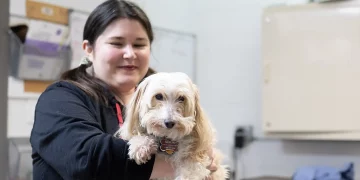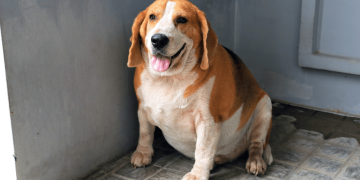Introduction:
Separation anxiety is a common issue faced by many pets, especially dogs. When left alone, pets can show signs of distress, such as destructive behavior, constant crying, or even accidents like urinating or defecating indoors. This emotional reaction not only affects their well-being but also creates challenges for pet owners. Fortunately, behavior training and some practical techniques can help alleviate most pets’ separation anxiety. In this article, we will explore the causes of separation anxiety, how to identify it in your pet, and provide effective training methods to help manage this issue.
1. What is Separation Anxiety?
Separation anxiety refers to the extreme stress and anxiety pets experience when separated from their owners or primary caregivers. For dogs, common signs of separation anxiety include:
- Constant barking or whining
- Loss of appetite or vomiting
- Excessive licking or chewing on themselves
- Inappropriate urination or defecation indoors
- Destructive behavior like chewing furniture or doors
- Over-excitement or fear when the owner leaves or returns home
Separation anxiety can be triggered by various factors, such as long periods of being alone, moving to a new environment, changes in the owner’s schedule, or sudden life changes. Pets with this condition often have difficulty coping with being left alone.
2. How to Recognize Separation Anxiety in Pets?
Not all pets show anxiety when separated from their owners, and the signs of separation anxiety can vary depending on the pet’s personality, age, and past experiences. Here are some common behaviors that may indicate your pet is suffering from separation anxiety:
- Excessive attachment: Does your pet follow you everywhere? Are they reluctant to let you out of their sight?
- Destructive behavior: Does your pet destroy furniture, doors, or other items when you leave the house?
- Constant vocalization: Does your pet bark, whine, or howl excessively when you leave or return home?
- Inappropriate elimination: Does your pet urinate or defecate indoors despite being house trained?
If you notice these signs consistently when your pet is left alone, it may be a sign of separation anxiety.

3. Effective Behavioral Training Tips to Manage Separation Anxiety
Fortunately, with patience and the right training, separation anxiety can be managed. Here are several practical behavior training tips that can help alleviate your pet’s anxiety:
a. Gradual Desensitization
Gradual desensitization involves getting your pet used to being alone in small increments over time. The goal is to desensitize your pet to the experience of separation so it becomes less stressful.
How to implement gradual desensitization:
- Start with short departures: Begin by leaving your pet alone for just a few minutes, and gradually increase the time you are gone.
- Keep goodbyes and hellos low-key: Avoid making a big fuss when leaving or returning home. Over-exaggerated greetings or farewells can increase your pet’s anxiety.
- Slowly build up time: Once your pet becomes comfortable with short separations, start increasing the time you are away, eventually leading to longer absences.
- Practice daily: Consistent training is key. Try practicing this training every day to help your pet adjust to the idea of being alone.
b. Create a Safe Space
Designating a safe, comfortable space for your pet can help them feel secure when you’re not around. This could be a crate, a specific room, or an area of the house where your pet feels at ease.
How to create a safe space:
- Comfortable environment: Add familiar blankets, toys, or your clothing to the space to help your pet feel more at ease.
- Toys and puzzles: Provide interactive toys or treat-dispensing puzzles that engage your pet mentally and keep them distracted while you’re gone.
- Quiet location: Ensure the space is away from too much noise or stimulation, allowing your pet to relax while you’re away.
c. Increase Physical and Mental Stimulation
Pets with high energy levels are more likely to develop anxiety when left alone. Increasing physical and mental stimulation can help reduce anxiety and make your pet more relaxed when you’re not home.
How to increase stimulation:
- Exercise: Make sure your pet gets plenty of physical activity before you leave. A long walk or playtime can help burn off excess energy.
- Mental enrichment: Provide puzzle toys, training sessions, or hide-and-seek games that challenge your pet’s mind. Mental stimulation can tire them out and make them more likely to relax when alone.
d. Provide Comfort Items
Some pets find comfort in familiar scents or objects. Leaving items that smell like you can help ease their anxiety when you’re not home.
What to try:
- Your clothing: Leave a worn shirt or blanket with your scent in their safe space.
- Comfort toys: Use soft toys that your pet can cuddle with while you’re away.
- Calming aids: Consider using calming sprays, pheromone diffusers, or music designed to soothe anxious pets.
e. Avoid Punishment
Punishing a pet for destructive behavior when you return home can worsen separation anxiety. Your pet doesn’t understand that the behavior is wrong—they are acting out of fear and stress. Instead, focus on positive reinforcement and reward calm behavior.
What to do instead:
- Redirect behavior: If your pet is exhibiting anxious behaviors like chewing, redirect them to an appropriate toy or activity.
- Reward calm behavior: When you return home and your pet is calm, offer treats, praise, or playtime as a reward.
- Keep comings and goings low-key: Reassure your pet through calm and neutral interactions rather than punishment.
4. When to Seek Professional Help
While most cases of separation anxiety can be managed with training and patience, some pets may require professional intervention. If your pet’s anxiety is severe or unresponsive to home-based training, it may be time to consult a professional trainer or a veterinary behaviorist.
Signs you should seek professional help:
- Your pet’s anxiety leads to self-harm, excessive destruction, or other dangerous behaviors.
- Training at home isn’t yielding progress after several weeks.
- Your pet’s anxiety is affecting their overall health or well-being.
A professional can help assess your pet’s behavior and create a customized plan to address their separation anxiety.
5. Conclusion
Separation anxiety can be a challenging issue, but with the right approach, most pets can learn to manage their anxiety and become more comfortable with being alone. Gradual desensitization, creating a safe space, providing mental and physical stimulation, and using comfort items are all effective strategies for reducing anxiety. Remember, patience and consistency are key to success. If your pet’s anxiety persists, don’t hesitate to seek professional guidance to help your furry friend lead a happier, less anxious life.
By addressing separation anxiety with proper training and care, you can ensure that both you and your pet enjoy a peaceful, anxiety-free time apart.























































